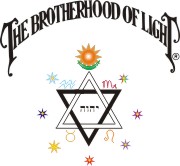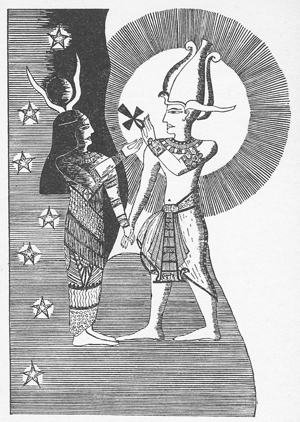|
|
Spiritual Meditations and Exercises Brotherhood of Light Lessons: Course Books on Astrology, Alchemy and Tarot
For Email Marketing you can trust
|
Serial Lesson 135From Course XII-2, Natural Alchemy
|
||||||||||||||||||||||||||||||||||||||||||||||
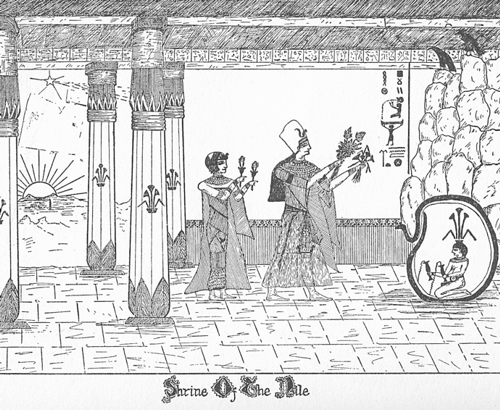 |
Yet even before this time, imported with the various deities from Babylon and Egypt, the astrological religion began to gain a foothold. No doubt, from the founding of Alexandria, 332 BC, its impetus increased. After 200 BC the state religion of Rome was rich in ritual and sacrificial offerings, in pomp and show, and in variety of gods worshiped, but sadly lacking in the emotional element that popularizes a religion. The result was that various cults gained sway, chief among them being the Mysteries of Mithra, in which the old Hermetic Teachings were perpetuated. That these mysteries were largely based on astrology is shown by the bas-reliefs, mosaics, and paintings of their subterranean temples, on which the emblems of the elements, the signs of the zodiac, and the symbols of the planets commonly appear.
Astrology had become so popular, and so widely accepted, by the time of the emperors that it was adopted by them as a matter of course. Official astrologers were quite the thing in the time of Augustus and Tiberius, and Nero’s teacher, Chaeremon, a priest of Alexandria, brought to his attention the religion of the stars as taught and practiced in Egypt. The sun came to be looked upon as the symbol of the Universal Creator, and in the temples three times daily—at dawn, at noon, and at dusk—a prayer was offered to the source of Life, Light and Love; a custom which survived in the early Christian Church as three daily services. Then, when it became expedient for political reasons, the priests, with whom Rome seems always to have been well stocked, suggested that the Emperor was the representative of the sun on earth. Thus in later days—even as in Japan until after World War II—it came about that men were deified and emperors worshiped as gods.
Through all these importations of deities the Roman people still held tenaciously to their belief in sympathetic magic, and to their belief in the worship of ancestral, household, tutelary, nature, and other spirits. Although Christianity was adopted as the state religion in 325 under Constantine, nevertheless the venerable temple of Vesta, where these various spirits were worshiped, remained open until 394 AD, when it was closed by Theodorus, and all such worship forbidden.
Ritual: Priestess of Isis with Sistrum
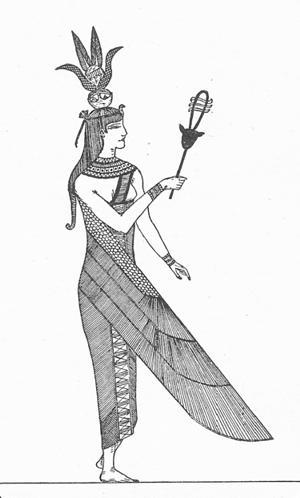
The state religion of Rome gave to the world an impressive ritual that in a modified form persists in the Roman Catholic religion of today. It also gave to Europe the idea of the divine right of kings.
Certain customs of the common people also have come down to European peasants even from the old Aegean beliefs. Such is the custom of swinging magically to help the growth of the grain. The higher one swings the higher the grain will grow. Likewise the custom of hoop rolling before the shortest day of the year to help the sun make this hard part of his annual circle. After the winter solstice this is no longer tolerated and there is then the commencement of top whipping for the purpose of helping the sun to come back to his former heat and power. (The Hopi Indians of America, as set forth in the reference book, Astrological Lore of All Ages, at this time also have a ceremony for calling back the sun.) After Good Friday, of course, the top whipping must cease, otherwise the heat of the sun might be too intense. And as a further instance of the tenacity of old customs it may be noted that the temple of Vesta, above mentioned, which endured in Rome some twelve hundred years, retained its ancient Aegean architecture, being covered with the primitive thatch and wattle to the last.
Religion of Early Britain
In the British Isles and on the west coast of Europe, during the development of the religions of Greece and Rome, was another religion very similar to that of the old Aegeans. This was Druidism. The Druids had an aphorism, “God cannot be matter and what is not matter must be God.”
They worshiped one Supreme Spirit, whose symbol is the sun. Like the Greeks and Romans, they believed in unseen spirits, and that objects were the vehicles of other spirits, or subordinate deities, to whom they must render homage. They believed in the evolution of the soul through the various lower forms of life before becoming man, and were confident man, after death, lived in a spiritual realm very similar to this world. So strong was this belief that money was borrowed in this world to be paid back in the next, and except for animals inimical to man and those used in sacrifices, they refrained from killing.
In writing, the Druids used two methods, one common and one sacred, the characters being very similar to those used by the Etruscans. Their religious ceremonies and other events of importance were commenced at definite astronomical configurations. Midday and midnight were two important times, and New Moon and Full Moon were observed for some purposes. They venerated the sun, moon and stars, and gave astronomical dances in their honor on religious occasions. Many such services began and ended with the ceremony of going around thrice in the direction of the sun, commencing in the East. This signified a willingness to obey the will of Deity. To go around in the opposite direction at such a ceremony signified rebellion against deific law, therefore devotion to witchcraft and black magic, which was severely punished. Human sacrifices were offered in times of national crisis, and at five year intervals, criminals being used for this purpose. One day out of every seven was held sacred.
As in nearly all countries at that time, information of value was imparted during the process of initiation. The chief method among the Druids was by means of oral verse. Before a candidate could enroll for the priesthood his moral qualities and intellectual powers were thoroughly investigated. When he was admitted as a candidate he was called Anewydd. After a time, if successful in passing the degree, he became a Bard, and later on might become an Ovate.
The final degree was that of Druid. It usually took about 20 years, largely spent in the forest, to become a Druid. In this initiation, in addition to religious and astrological matters, he was fully instructed in magic. He became skilled in the use of the magic wand, which is still known as the Rod of Druidism. He became a proficient healer, developed clairvoyance and prophecy, and practiced various forms of divination. Tradition relates that the Druids competed with the early saints in working miracles. The old Celtic Laws, revised 449 AD by St. Patrick, were the work of the Druids. In their social relations they believed in and practiced a high moral code. (For further information, refer to, Druidism, the Ancient Faith of Britain, by Dudley Wright).
Manachaeism
This doctrine derived from the teachings of a Persian of the third century AD, called Mani, Manes or Manichaeus, who taught a dualism derived from Zoroastrianism. Manes, born 216 AD, either claimed to be, or was regarded by his followers as the Paraclete promised by Jesus (John 14:16-17). Following Zoroaster, he postulated two beings, Light (God) and Darkness. From the latter Satan and his angels were born. Adam owed his being to Satan. Continued conflict exists between the two kingdoms, and when the Kingdom of Light becomes victorious the world will be destroyed by fire and God will thenceforth reign.
This sect, in its time considered a Christian heresy, endeavored to reconcile Christianity, Buddhism and Mazdaism into a world religion much as present-day Bahaism (see Chapter 4 - Serial Lesson 136), which is a Mohammedan heresy, now seeks to reconcile Mohammedanism, Buddhism and Christianity.
The Old Testament was rejected and only so much of the New Testament was accepted as served their purpose. They had a kind of hierarchy, fasting was practiced, and among the later Manichaeans rites existed analogous to baptism and the Eucharist. The ethics of the sect were severely ascetic. Their members were divided into two classes, the “elect” and the “hearers.”
The “elect” were bound to observe three seals: (1) of the mouth, forbidding animal food, the use of wine and milk, and impure speech; (2) of the hands, forbidding the destruction of life, whether animal or vegetable; and (3) of the bosom, forbidding marriage and offspring, since woman was supposed to have been the gift of demons. The “hearers” were less severely bound.
This sect rapidly spread in the East and to North Africa. But it was drastically persecuted, and in the fifth century was completely stamped out, although some of its tenets reappeared later in the doctrines of the Paulicians and later on in those of the Albigenese.
Nestorianism
Nestorius, Bishop of Constantinople from 428 to 431, taught that there were two persons as well as two natures in Jesus Christ, and that the Virgin Mary was in no sense Mother of God; she was the mother of Jesus, but not the mother of the Word. Cyril of Alexandria, at the Council of Ephesus in 431, procured the condemnation of the Nestorian doctrines, and the deposition of Nestorius. The latter was banished to the deserts of Egypt, where he underwent much suffering, and died in 440.
Nestorianism made rapid strides in the East, and together with the Monophysites, also called Jacobites—who believed there was only one nature in Christ, namely that of the Word, who became incarnate, and that the divine and human elements in that one nature were blended as the body and soul in man—in the eleventh century outnumbered those of the Orthodox and the Roman Catholic churches together. After 1553 some of the Nestorians were in communion with Rome, and were known as Chaldeans.
Druses
Another sect, this time arising in Syria where it has its strongest hold today—about 100,000 followers endeavored to unite Christians, Moslems, Jews, Buddhists and Mazdeans. According to their religion, dating from the beginning of the eleventh century, Hakim, the sixth of the Fatimite caliphs was the tenth and last incarnation of God. Hakim, who thus proclaimed himself, when walking in the vicinity of Cairo, his capital, disappeared. His followers believe he will return to earth to reign over it and propagate their faith.
Two Persians spread this doctrine with great zeal Hamzeh and Mohammed ben Ismailed or Durzi. The latter became known so widely that instead of calling its followers Hakimites they came to be known as Druses.
They believe in the unity of God, who they think was manifest in the persons of several individuals, the last being Hakim. They believe in the constant existence of five superior spiritual ministers, the greatest being Hamzeh and Jesus. They firmly believe in the transmigration of souls. Their day of worship is Thursday. They adhere to seven commandments given by Hamzeh, who succeeded the original founder of the sect. These are: (1) Truthful speech among themselves; (2) care of their brethren; (3) renunciation of all other religions; (4) separation from heretics; (5) confession of the unity of God in all ages; (6) resignation to His will, and (7) obedience to His commands. They believe also that to profess belief in another religion for the purpose of gaining the confidence of others whom they hope to proselyte is meritorious.
The Mormons
Space does not permit me even to list all the Christian sects, let alone explaining their tenets. But they have sprung up, one after another since the dawn of Christianity. In addition to the few previously mentioned, for instance, in the first century there were the Ebionites, who held that Jesus was only a man, upon whom the spirit of God descended at His Baptism, and whom the spirit of God deserted at the time of the crucifixion.
Then there were the Adamites, an early Christian sect who held, as did another sect, the Nikolartans, that wives, like everything else should be held in common by true Christians. They celebrated certain rites in caves where all assembled naked and gave themselves up to promiscuous indulgences.
Of quite opposite character were the Christian Gnostics of the third century. These, for the most part, were learned philosophers who sought to reconcile Christianity and Greek philosophy.
Space does not permit discussing even the outstanding present-day Christian sects, but as throwing some light upon the manner in which a religion gets a foothold, and may at least temporarily be sidetracked, I believe I should speak of The Church of Jesus Christ of the Latter Day Saints, often spoken of as the Mormon religion, which has among its members many intelligent, capable, and conscientious people.
On September 23, 1823, the angel Moroni appeared to Joseph Smith thrice and commanded him to find in the forest a supplement to the Bible. Smith claimed later that an angel gave him the book, consisting of gold leaves in a stone box. This book was in the “Reformed Egyptian” writing, in size octave, 8x7 inches, and 6 inches thick, fastened with three gold rings. With it were a pair of spectacles with crystal lenses by means of which Smith could understand the writing. The contents of this book he dictated from behind a curtain to Oliver Cowdry; and Cowdry and Farmer Harris were induced to pay for its publication as the Book of Mormon. On this book The Church of Jesus Christ of the Latter Day Saints was founded.
This early Book of Mormon forbade polygamy. But later Joseph Smith became enamored with a woman other than his wife, and about that time, July 1843, the prophet received a new revelation on the subject, and established “Sealed Wives” in addition to the legitimate wife. Then the religion became subject to relentless persecution, and its followers, after making several moves, finally went to the desert region of the Great Basin and made their headquarters at Salt Lake City, Utah, which is the present stronghold of the faith.
The doctrine of polygamy, however, gave them a great amount of trouble, being particularly used against them politically. Some in the church, even from the first, were opposed to it. This resulted finally in the establishment of the “Reorganized Latter Day Saints.” This organization holds plurality of wives to be an abomination. They hold that the Book of Mormon is an authentic history of America between 2,000 BC and 400 AD. They are convinced that Jesus Christ is the Savior, that Mohammed is the second great prophet, and that Joseph Smith came to crown and complete the work of these other two, being the third and last great prophet. In their acceptance of the Bible and the Book of Mormon on faith, regardless of logical contradictions, they greatly resemble the Christian Fundamentalists.
Mystics and Monastic Life
Instead of viewing religion as teaching how the ordinary life should be modeled, some in each of the more important religions viewed it as an end in itself. They became religious devotees to the exclusion of all other matters. Thus did monastic life spring into being.
Among the Hindus the fakir with his begging bowl, and perhaps his bag of tricks, is a common sight. The Buddhists have great monasteries where those who have turned from the world and adopted religion as their sole interest dwell. Among the Mohammedans there are dervishes. These correspond to the monks of Christianity, there being numerous orders of them. Some are on the plane of the low Hindu fakir, living by begging and a few tricks of legerdemain. Many of the orders of dervishes have no settled abode, but wander from place to place. Some are of a rather high order and possess pronounced occult powers. Among these are accomplished magicians and healers.
Of the Christians, there are several hundred orders of monks that have come into existence since the religion was founded. All have heard of the Wandering Friars, of the Franciscan monks, and of the Jesuits. Some of the orders that once had a membership, however, no longer are in existence. And if we were to take the pains to examine the requirements of membership of these monastic orders of different religions, and if we were to inquire the objective which they hope to attain, and if we were to learn how they live, and who supports them, we should find in essential matters all are remarkably the same.
Monastic life, however, is not the only byproduct of the great religions of the world. Among all the great religions there have been groups of mystics, groups of those who believe they reach Deity by retiring within themselves.
I presume no one need be told that the Yogis of Hinduism, through meditation, breathing, fasting, posture, etc., enter into higher states of consciousness in which they claim to receive illumination. There are likewise mystics among the Buddhists, and among the Taoists. Mazdaism, which was a modified form of Zoroastrianism, once had many notable mystics. Among the Mohammedans the mystics are called Sufi, and the Sufi movement is alive today, and in the past profoundly influenced literature. Christian mysticism also produced a very extensive literature. I need but mention Jacob Boehme, Emanuel Swedenborg, Von Ekartshausen and Louis Claude de St. Martin to bring to mind a few of the later Christian mystics and their writings.
Modern Fetishism
Egypt and the region bordering the Mediterranean are Mohammedan. But the balance of Africa is the present-day stronghold of Animism, Totemism and Fetishism. These beliefs and the practices arising from them vary with districts, and somewhat with different peoples, but almost everywhere in Africa these three forms are apparent. The native African, North, South, East and West, in spite of any later modifying influence, is a firm believer in various orders of spirits, that the dead have the ability to return, and that they have an influence over the lives of those yet living. He is also a firm believer in magic, and ardently seeks to have it used for his personal gain. Oje men (witch doctors) of various kinds are sought upon all unusual occasions, and their offices are secured in attempts to gain whatever is desired. Among many tribes almost every ill is thought to be the result of sorcery. Totem restrictions are scrupulously observed, and fetishes are secured to assist its possessor, and also for the purpose of injuring his enemy.
In Chapter 1 (Serial Lesson 133), under the heading, Fetishism, a quotation was given from Robert H. Milligan’s, The Jungle Folk of Africa, among whom he lived as a Christian missionary. It was about the skull of the father which the son kept in a box. Later he says, “They believe that the skull of the father or other ancestor when it has been properly prepared becomes the resident of the ancestor, who, however, is not confined to it, but wanders about returning to it as to his home.”
Here we see not merely a high development of fetishism, but also the origin and significance of ancestor worship. The skull fetish is never abused, for it is believed abuse would cause it to become angry and bring evil upon its possessor. Being the home of the spirit of the ancestor, the skull is kept comfortable, warm and dry, rubbed occasionally with oil and redwood powder, and well fed. Before going hunting the box in which the skull is kept is opened and the son addresses the skull as he might if it were still alive, asking his father to help him, and promising he will share the game killed with him. On returning from the hunt the son opens the box and places a portion of the game before the skull, himself leaving the house and locking it against intrusion while his father eats. The father is supposed to eat only the invisible double of the food. After giving the father ample time to do this, the son returns to the house and himself eats the food that was before the skull.
Before turning from these tribes of West Coast Africa, another quotation from Mr. Milligan may prove interesting. It reports the case of a native who believed in just such hauntings as the numerous instances cited in Haunted Houses, by Camile Flammarion. He says:
“On Corsica Island there lives a man who had been in contact with civilization all his lifetime and is fairly educated though he is not a Christian. His wife died, and shortly afterward she began playing pranks in his town and even in his house. She broke nearly all his dishes. Then, one night she struck him in the neck, and he instantly recognized her. His neck was stiff in the morning. That proved it! Not being able to strike back in the unequal warfare and preferring an enemy whom he could kick (for this individual wore shoes and scarcely anything else) he lost spirit and finally pulled down the entire town and built in another place.”
The more common fetishes are not treated with the great respect accorded to the ancestor’s skull. More often they are talked to and treated as if human. If a fetish fails to obtain the desired end it is either placated or punished. In Africa fetishes are sometimes sprinkled with oil, rum, or blood to gain their favor, and they are maligned, beaten and abused when they fail in their performance.
A large number of fetish practices are to be found among those above savages, such as the general belief of the American trapper that if he sells all his fur he will have difficulty in catching more. He therefore keeps one piece of fur, even though the poorest pelt, that it may draw other fur to him when he starts trapping the next season. The relic of some saint, a piece of the cross, or a portion of the Koran, when believed to possess supernormal power is a fetish. Nor is the abusing of fetishes confined to savages. I quote from Professor Hopkin’s History of Religion:
“It is exactly the attitude taken by the Egyptians and Greeks toward their gods. Even later Romans destroyed the temples to punish the gods on the death of Germanicus. So also in the seventeenth century a crew of becalmed Portuguese sailors tied their patron, St. Anthony, to the bowsprit till he sent a breeze. A Spanish captain once tied the Virgin to the mast with the same intent. There is, however, another element to be considered, which looks somewhat like simple abuse, but is not. Thus St. Peter’s image was once immersed, in the sixteenth century, to cure a drought in France. This may have been a case of sympathetic magic, wetting the saint to cause him to wet the earth. But there are cases enough to show that abuse is reckoned a proper way to control a spiritual power. Russian peasants beat their holy pictures with no other idea.”
Fetishism may very easily lead to idolatry. The reverence for a fetish may lead to its worship. The desire to propitiate and gain the help of ancestors may lead to the worship of the images of such ancestors. In China pictures of ancestors are preferred to images. In India and New Zealand images of stone or wood are preferred. The Hindu Rajput occasionally wears an amulet to keep away evil spirits. It will be seen that to the undiscriminating mind the image of the Virgin Mary, or of Jesus on the cross, or even the cross, from being a symbol of spiritual power to be venerated might easily by gradual steps degenerate into an idol to be worshiped.
Sankhya and Vedanta
Among the more notable philosophic religions of India are the Sankhya and the Vedanta. The Sankhya is essentially dualistic, emphasizing the difference between spirit and matter. There is, however, a theistic form of Sankhya, which in its other forms is commonly atheistic, called the Puranic Sankhya; and Patanjali’s Yoga is thoroughly theistic. Cankara was a great Vedanta leader in the ninth century, but in the twelfth century Ramanuja arose to dispute his interpretations.
The sectarian pantheism of the present time arose from Ramanuja’s doctrines. The religion split into two sects, one numerically stronger, holding that the All-spirit, Vishnu, incarnated through Krishna, and the other that Vishnu incarnated through Rama. Thus we have the Krishnaites and the Ramaites. Then the Krishnaites split into numerous sects, and these into sub-sects; and the Ramaites split into numerous sects and sub-sects, these smaller sub-sects mutually hating each other even more than they do their common adversaries of the larger division.
Panthia
One of the most distinguished Vedantists of the fifteenth century was Kabir, who founded the sect known as Kabir Panthia. Their belief is an unsectarian unitarianism. That is, they have no rites, renounce idolatry, ridicule the scriptures, and broke with both the Mohammedans and the orthodox Hindus There are twelve divisions of these Panthia, mostly in the South, near Benares in the East, and near Bombay in the West.
Sikhs
In the fifteenth century was born Nanak, who about the year 1500 in the Punjab region started a religious reform movement. He claimed to be a follower of Kabir. The sect has a sacred work, the Granth, compiled by pontiff Arjun and others. The Sikh pontiff was Guru Govind, and under his rule in the eighteenth century the church became aggressive and developed into a powerful military organization.
Its followers believe in one god, prohibit idolatry, pilgrimages, the use of charms, belief in witchcraft, and in the caste system, and they refuse to recognize Brahmanical supremacy. They are renowned fighters, and take a vow to hate both Hindus and Mohammedans. Their early leader’s orders were, “If you meet a Mohammedan, kill him; if you meet a Hindu beat and plunder him.” Their chief stronghold still is in the Punjab region. There are seven well-defined sub-sects at present.
Jainism
About the sixth century B.C. Mahavira Jnatriputra founded a religion in the Southern and Western provinces of Hindustan which attempted to reconcile Hinduism and Buddhism, embracing features of both. It is the religion of the Jains, with about a million and a half followers in India.
Its chief difference from Hinduism is that (1) it denies that the Veda is of divine origin, (2) it worships certain holy mortals who, by living exemplary lives here and by self-mortification had raised themselves above humanity to the station of gods, (3) it teaches extreme tenderness toward all animal life. In all of these three points it tends toward Buddhism.
Its moral code or “great duties” consists of (1) refraining from injury to life, (2) truth, (3) honesty, (4) chastity, and (5) freedom from worldly desires.
Its four other teachings, or “merits” are (1) liberality, (2) gentleness, (3) piety, and (4) penances.
Zenism
In Japan, a sect revolted against the idolatry of the Buddhism as there practiced, and hold that book knowledge is in vain and that one must look within. Not long after the Zen sect came into existence in the twelfth century, two other popular sects arose sometimes called the Happy Land sects, because they teach that salvation may be attained not through knowledge of illumination, but through faith. The Jodo sect, one of the Happy Land sects, later branched and one section is called the Jodo-Shinshu. At present this sect has ten sub-sects and not less than 20 thousand temples in Japan. The Zen sect is almost as strong.
To purchase the print book Natural Alchemy Part 2: Evolution of Religion click here
|
||||||||
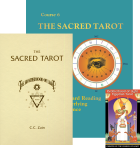 The Sacred Tarot |
Horoscope Software Hermetic Astrology |
Articles and Papers by Elbert Benjamine |
 History of the Adepts, Spiritual Ancestors of The Brotherhood of Light Lessons |
Global Astrology Forecasts and Reports |
Additional Articles, Reports, History, Data |
Order of the Sphinx Research |
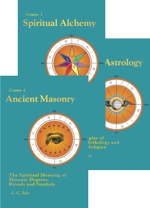 Brotherhood of Light 21 Courses eBooks PDF Downloads Kindle iPad, iPhone & Android |
|
Copyright © 2025 All Rights Reserved |
The Church Of Light (USA) 501(c)(3) organization Phone: 800-500-0453 / 505-247-1338 Fax: 505-814-7318 / Email: churchoflight@light.org Privacy Policy | Shipping & Returns Policy | Contact Us |





